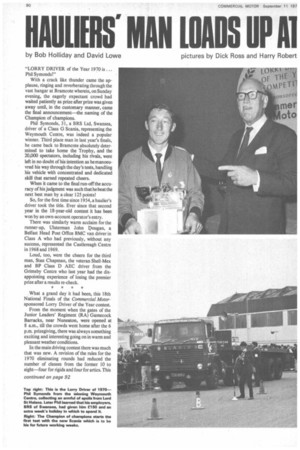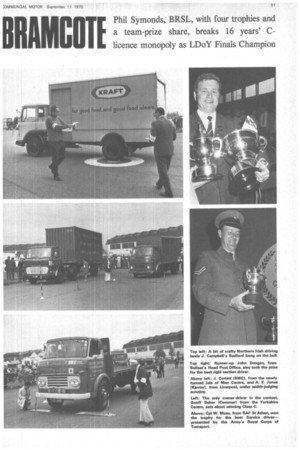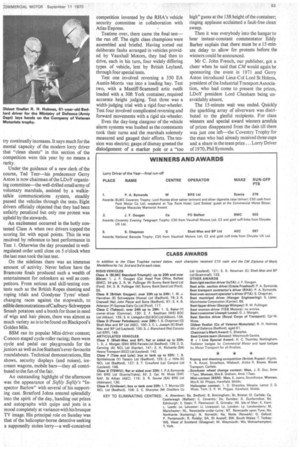HAULIERS' MAN LOADS UP Al BRACE
Page 88

Page 89

Page 90

Page 91

If you've noticed an error in this article please click here to report it so we can fix it.
Phil Symonds, BRSL, with four trophies and a team-prize share, breaks 16 years' Clicence monopoly as LDoY Finals Champion
by Bob Holliday and David Lowe pictures by Dick Ross and Harry Robert
"LORRY DRIVER of the Year 1970 is . Phil Symonds!"
With a crack like thunder came the applause, ringing and reverberating through the vast hangar at Bramcote wherein, on Sunday evening, the eagerly expectant crowd had waited patiently as prize after prize was given away until, in the customary manner, came the final announcement—the naming of the Champion of champions.
Phil Symonds, 31, a BRS Ltd, Swansea, driver of a Class G Scania, representing the Weymouth Centre, was indeed a popular winner. Third place man in last year's finals, he came back to Bramcote absolutely determined to take home the Trophy, and the 20,000 spectators, including his rivals, were left in no doubt of his intention as he manoeuvred his way through the day's tests, handling his vehicle with concentrated and dedicated skill that earned repeated cheers.
When it came to the final run-off the accuracy of his judgment was such that he beat the next best man by a clear 125 points!
So, for the first time since 1954, a haulier's driver took the title. Ever since that second year in the 18-year-old contest it has been won by an own-account operator's entry.
There was similarly warm acclaim for the runner-up, Ulsterman John Dougan, a Belfast Head Post Office BMC van driver in Class A who had previously, without any success, represented the Castlereagh Centre in 1968 and 1969.
Loud, too, were the cheers for the third man, Stan Chapman, the veteran Shell-Mex and BP Class D AEC driver from the Grimsby Centre who last year had the disappointing experience of losing the premier prize after a results re-check.
What a grand day it had been, this 18th National Finals of the Commercial Motorsponsored Lorry Driver of the Year contest.
From the moment when the gates of the Junior Leaders' Regiment (RA) Gamecock Barracks, near Nuneaton, were opened at 8 a.m., till the crowds went home after the 6 p.m. prizegiving, there was always something exciting and interesting going on in warm and pleasant weather conditions.
In the main driving contest there was much that was new. A revision of the rules for the 1970 eliminating rounds had reduced the number of classes from the former 10 to eight—four for rigids and four for artics. This resulted in a total entry of 279, of which 20 failed to reach the starting line. Since the previous year seven new centres had been formed—in the Isle of Man, Bedford, Bristol, Carlisle, Newark, Norwich and Wolverhampton—to make a total of 36.
Once again the time-saving system of putting the vehicles through duplicated sets of tests was used. Three of the well-known ones came first—reversing into a loading bay, width judgment and kerb parking; the fourth test was a new one—distance judgment in which drivers had to estimate from their stationary vehicles the distances in feet to a number of road signs set out ahead.
"Classroom" work again involved an examination on the Highway Code, legal requirements and mechanical safety factors. This test becomes increasingly difficult as legislation affecting the road transport i ndus
continued on page 97
try continually increases. It says much for the mental capacity of the modern lorry driver that "clean sheets" in this section of the competition were this year by no means a rarity.
Under the guidance of a new clerk of the course, Ted Teer-his predecessor Gerry Aston is now chairman of the LDoY organizing committee-the well-drilled small army of voluntary marshals, assisted by a walkietalkie communications system, steadily passed the vehicles through the tests. Eight drivers officially objected that they had been unfairly penalized but only one protest was upheld by the stewards.
An excitement occurred in the hotly contested Class A when two drivers topped the scoring list with equal points. This tie was resolved by reference to best performance in Test 1. Otherwise the day proceeded in wellregulated order until close on 5 o'clock when the last man took the last test.
On the sidelines there was an immense amount of activity. Never before have the Bramcote finals produced such a wealth of entertainment for onlookers as well as competitors. From serious and skill-testing contests such as the British Ropes sheeting and roping trials and Goodyear Tyres' wheelchanging races against the stopwatch, to edible demonstrations ofC adbury-Schweppes Smash potatoes and a booth for those in need of wigs and hair pieces, there was almost as much variety as is to be found on Blackpool's Golden Mile.
BSM ran its popular Mini-driver contest; Conoco staged cycle-roller racing; there were cycle and pedal car playgrounds for the juniors as well as Joe Statham's ever-favourite roundabouts. Technical demonstrations, film shows, security displays (and noises), icecream wagons, mobile bars-they all contributed to the fun of the fair.
An outstanding highlight of the afternoon was the appearance of Softly Softly's "Inspector Barlow" with several of his supporting cast. Stratford Johns entered splendidly into the spirit of the day, handing out prizes and autographs with quips and jests in a mood completely at variance with his brusque TV image. His principal role on Sunday was that of the helicopter-borne detective seeking a supposedly stolen lorry-a well-conceived
competition invented by the RHA's vehicle security committee in collaboration with Atlas Express.
Teatime over, there came the final testthe run off. The eight class champions were assembled and briefed. Having sorted out deliberate faults arranged in vehicles provided by Vauxhall Motors, they had then to drive, each in his turn, four widely differing types of vehicle, lent by British Leyland, through four special tests.
Test one involved reversing a 350 EA Austin-Morris van into a loading bay. Test two, with a Mastiff-Scammell artic outfit loaded with a 30ft York container, required accurate height judging. Test three was a width-judging trial with a rigid four-wheeler. Test four involved complicated reversing and forward movements with a rigid six-wheeler.
Even the day-long clangour of the vehicle alarm systems was hushed as the contestants took their turns and the marshals solemnly measured and gauged their efforts. The tension was electric; gasps of dismay greeted the dislodgement of a marker pole or a "too high" guess at the 13 ft height of the container, ringing applause acclaimed a fault-free clean sweep.
Then it was everybody into the hangar to hear instant-constant commentator Eddy Barber explain that there must be a 15-minute delay to allow for protests before the winners could be announced.
Mr C. John French, our publisher, got a cheer when he said that CM would again be
sponsoring the event in 1971 and Gerry Aston introduced Lieut-Col Lord St Helens, president of the Industrial Transport Associa tion, who had come to present the prizes, LDoY president Lord Chesham being unavoidably absent.
The 15-minute wait was ended. Quickly the sparkling array of silverware was distri buted to the gleeful recipients. For class Winners and special award winners armfuls of prizes disappeared from the dais till there was just one left-the Coventry Trophy for the man who had already received three cups and a share in the team prize ... Lorry Driver of 1970, Phil Symonds.




















































































































































































































































